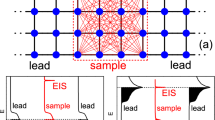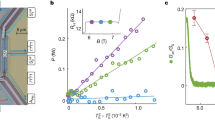Abstract
In transport experiments, the quantum nature of matter becomes directly evident when changes in conductance occur only in discrete steps1, with a size determined solely by Planck’s constant h. Observations of quantized steps in electrical conductance2,3 have provided important insights into the physics of mesoscopic systems4 and have allowed the development of quantum electronic devices5. Even though quantized conductance should not rely on the presence of electric charges, it has never been observed for neutral, massive particles6. In its most fundamental form, it requires a quantum-degenerate Fermi gas, a ballistic and adiabatic transport channel, and a constriction with dimensions comparable to the Fermi wavelength. Here we report the observation of quantized conductance in the transport of neutral atoms driven by a chemical potential bias. The atoms are in an ultraballistic regime, where their mean free path exceeds not only the size of the transport channel, but also the size of the entire system, including the atom reservoirs. We use high-resolution lithography to shape light potentials that realize either a quantum point contact or a quantum wire for atoms. These constrictions are imprinted on a quasi-two-dimensional ballistic channel connecting the reservoirs7. By varying either a gate potential or the transverse confinement of the constrictions, we observe distinct plateaux in the atom conductance. The conductance in the first plateau is found to be equal to the universal conductance quantum, 1/h. We use Landauer’s formula to model our results and find good agreement for low gate potentials, with all parameters determined a priori. Our experiment lets us investigate quantum conductors with wide control not only over the channel geometry, but also over the reservoir properties, such as interaction strength, size and thermalization rate.
This is a preview of subscription content, access via your institution
Access options
Subscribe to this journal
Receive 51 print issues and online access
$199.00 per year
only $3.90 per issue
Buy this article
- Purchase on Springer Link
- Instant access to full article PDF
Prices may be subject to local taxes which are calculated during checkout




Similar content being viewed by others
References
Imry, Y. in Directions in Condensed Matter (eds Grinstein, G. & Mazenko, G. ) 120–145 (World Scientific, 1986)
van Wees, B. J. et al. Quantized conductance of point contacts in a two-dimensional electron gas. Phys. Rev. Lett. 60, 848–850 (1988)
Wharam, D. A. et al. One-dimensional transport and the quantisation of the ballistic resistance. J. Phys. C 21, L209 (1988)
Imry, Y. Introduction to Mesoscopic Physics (Oxford Univ. Press, 2002)
Ihn, T. Semiconductor Nanostructures (Oxford Univ. Press, 2010)
Sato, Y., Eom, B.-H. & Packard, R. On the feasibility of detecting quantized conductance in neutral matter. J. Low Temp. Phys. 141, 99–109 (2005)
Brantut, J.-P., Meineke, J., Stadler, D., Krinner, S. & Esslinger, T. Conduction of ultracold fermions through a mesoscopic channel. Science 337, 1069–1071 (2012)
Landauer, R. Spatial variation of currents and fields due to localized scatterers in metallic conduction. IBM J. Res. Develop. 1, 223–231 (1957)
Büttiker, M., Imry, Y., Landauer, R. & Pinhas, S. Generalized many-channel conductance formula with application to small rings. Phys. Rev. B 31, 6207–6215 (1985)
Krans, J. M., van Ruitenbeek, J. M., Fisun, V. V., Yanson, I. K. & de Jongh, L. J. The signature of conductance quantization in metallic point contacts. Nature 375, 767–769 (1995)
Frank, S., Poncharal, P., Wang, Z. L. & de Heer, W. A. Carbon nanotube quantum resistors. Science 280, 1744–1746 (1998)
Thywissen, J. H., Westervelt, R. M. & Prentiss, M. Quantum point contacts for neutral atoms. Phys. Rev. Lett. 83, 3762–3765 (1999)
Görlitz, A. et al. Realization of Bose-Einstein condensates in lower dimensions. Phys. Rev. Lett. 87, 130402 (2001)
Moritz, H., Stöferle, T., Köhl, M. & Esslinger, T. Exciting collective oscillations in a trapped 1D gas. Phys. Rev. Lett. 91, 250402 (2003)
Paredes, B. et al. Tonks–Girardeau gas of ultracold atoms in an optical lattice. Nature 429, 277–281 (2004)
Kinoshita, T., Wenger, T. & Weiss, D. S. Observation of a one-dimensional Tonks-Girardeau gas. Science 305, 1125–1128 (2004)
Bouchoule, I., van Druten, N. & Westbrook, C. in Atom Chips (eds Reichel, J. & Vuletic, V. ) 331–363 (Wiley, 2010)
Serwane, F. et al. Deterministic preparation of a tunable few-fermion system. Science 332, 336–338 (2011)
Albiez, M. et al. Direct observation of tunneling and nonlinear self-trapping in a single bosonic Josephson junction. Phys. Rev. Lett. 95, 010402 (2005)
Stadler, D., Krinner, S., Meineke, J., Brantut, J.-P. & Esslinger, T. Observing the drop of resistance in the flow of a superfluid Fermi gas. Nature 491, 736–739 (2012)
Krinner, S., Stadler, D., Meineke, J., Brantut, J.-P. & Esslinger, T. Superfluidity with disorder in a thin film of quantum gas. Phys. Rev. Lett. 110, 100601 (2013)
van Houten, H. & Beenakker, C. Quantum point contacts. Phys. Today 49, 22–27 (1996)
Zimmermann, B., Müller, T., Meineke, J., Esslinger, T. & Moritz, H. High-resolution imaging of ultracold fermions in microscopically tailored optical potentials. New J. Phys. 13, 043007 (2011)
Glazman, L. I. & Lesovik, G. B. Khmel’Nitskiǐ, D. E. & Shekhter, R. I. Reflectionless quantum transport and fundamental ballistic-resistance steps in microscopic constrictions. JETP Lett. 48, 238–241 (1988)
Kouwenhoven, L. P. et al. Nonlinear conductance of quantum point contacts. Phys. Rev. B 39, 8040–8043 (1989)
Ulreich, S. & Zwerger, W. Where is the potential drop in a quantum point contact? Superlattices Microstruct. 23, 719–730 (1998)
Szafer, A. & Stone, A. D. Theory of quantum conduction through a constriction. Phys. Rev. Lett. 62, 300–303 (1989)
Yacoby, A. & Imry, Y. Quantization of the conductance of ballistic point contacts beyond the adiabatic approximation. Phys. Rev. B 41, 5341–5350 (1990)
Vignale, G. & Di Ventra, M. Incompleteness of the Landauer formula for electronic transport. Phys. Rev. B 79, 014201 (2009)
Hasan, M. Z. & Kane, C. L. Topological insulators. Rev. Mod. Phys. 82, 3045–3067 (2010)
Sachdev, S. Quantum Phase Transitions 260–290 (Cambridge Univ. Press, 2011)
Lee, P. A. & Stone, A. D. Universal conductance fluctuations in metals. Phys. Rev. Lett. 55, 1622 (1985)
Brantut, J.-P. et al. A thermoelectric heat engine with ultracold atoms. Science 342, 713–715 (2013)
Hung, C.-L., Zhang, X., Gemelke, N. & Chin, C. Accelerating evaporative cooling of atoms into Bose-Einstein condensation in optical traps. Phys. Rev. A 78, 011604 (2008)
Beria, M., Iqbal, Y., Di Ventra, M. & Müller, M. Quantum-statistics-induced flow patterns in driven ideal Fermi gases. Phys. Rev. A 88, 043611 (2013)
Gattobigio, G. L., Couvert, A., Georgeot, B. & Guéry-Odelin, D. Exploring classically chaotic potentials with a matter wave quantum probe. Phys. Rev. Lett. 107, 254104 (2011)
O’Hara, K. M., Gehm, M. E., Granade, S. R. & Thomas, J. E. Scaling laws for evaporative cooling in time-dependent optical traps. Phys. Rev. A 64, 051403 (2001)
Du, X., Zhang, Y. & Thomas, J. E. Inelastic collisions of a fermi gas in the BEC-BCS crossover. Phys. Rev. Lett. 102, 250402 (2009)
Zürn, G. et al. Precise characterization of Li6 Feshbach resonances using trap-sideband-resolved RF spectroscopy of weakly bound molecules. Phys. Rev. Lett. 110, 135301 (2013)
Migdal, A. Qualitative Methods in Quantum Theory 115–118 (Perseus, 2000)
Büttiker, M. Role of quantum coherence in series resistors. Phys. Rev. B 33, 3020–3026 (1986)
Ulreich, S. Transport Durch Ballistische Leiter 44–52, PhD thesis, LMU München. (1997)
Acknowledgements
We acknowledge discussions with G. Blatter, K. Ensslin, C. Glattli, T. Giamarchi, C. Grenier and M. Lebrat, and thank C. Chin, T. Ihn, Y. Imry, and W. Zwerger for their careful reading of the manuscript and for discussions. We acknowledge financing from NCCR QSIT, the ERC Project SQMS, the FP7 project SIQS and ETHZ. J.-P.B. is supported by the Ambizione program of SNF.
Author information
Authors and Affiliations
Contributions
All authors contributed equally to this work.
Corresponding author
Ethics declarations
Competing interests
The authors declare no competing financial interests.
Extended data figures and tables
Extended Data Figure 1 Distribution of timescales in the reservoirs.
The corresponding physical phenomena are indicated on the time line. The meanings of the different notations are defined in the text.
Extended Data Figure 2 Conductance as a function of gate potential for non-interacting reservoirs.
Filled magenta squares correspond to a scattering length of a = −4a0, whereas open blue circles represent a reference data set for weakly interacting reservoirs, where a = −187a0. Each data point is the mean of nine measurements, and error bars indicate one standard deviation. The black line is a theoretical prediction based on the Landauer formula of conductance, and the shaded region reflects the uncertainties in the input parameters.
Extended Data Figure 3 Illustration of the adiabaticity criterion.
Transverse energy level spacing Δωx = ΔEx /h along the tightly confined QPC direction (solid red line), and corresponding temporal change in the ground-state trapping frequency in the moving frame of the atoms  as a function of position along the QPC for the three possible values of nz when q = 3 modes are populated.
as a function of position along the QPC for the three possible values of nz when q = 3 modes are populated.
Extended Data Figure 4 Conductance of the 2D region and of the QPC as a function of gate potential.
a, Conductance G2D as a function of gate potential in the absence of the QPC. The solid line is a linear fit to the data. b, Conductance GQPC of the QPC only, when considering the contact resistances of the 2D confinement as series resistors to the QPC. The data set, colour code, solid line and shaded region are the same as in Extended Data Fig. 2. Error bars are obtained by propagating the errors in G and G2D.
Rights and permissions
About this article
Cite this article
Krinner, S., Stadler, D., Husmann, D. et al. Observation of quantized conductance in neutral matter. Nature 517, 64–67 (2015). https://doi.org/10.1038/nature14049
Received:
Accepted:
Published:
Issue Date:
DOI: https://doi.org/10.1038/nature14049
This article is cited by
-
Irreversible entropy transport enhanced by fermionic superfluidity
Nature Physics (2024)
-
Superconductivity, superfluidity and quantum geometry in twisted multilayer systems
Nature Reviews Physics (2022)
-
Observation of spin-space quantum transport induced by an atomic quantum point contact
Nature Communications (2021)
-
Generation of spin currents by a temperature gradient in a two-terminal device
Communications Physics (2021)
-
Strong-Coupling Effects on Quantum Transport in an Ultracold Fermi Gas
Journal of Low Temperature Physics (2020)
Comments
By submitting a comment you agree to abide by our Terms and Community Guidelines. If you find something abusive or that does not comply with our terms or guidelines please flag it as inappropriate.



